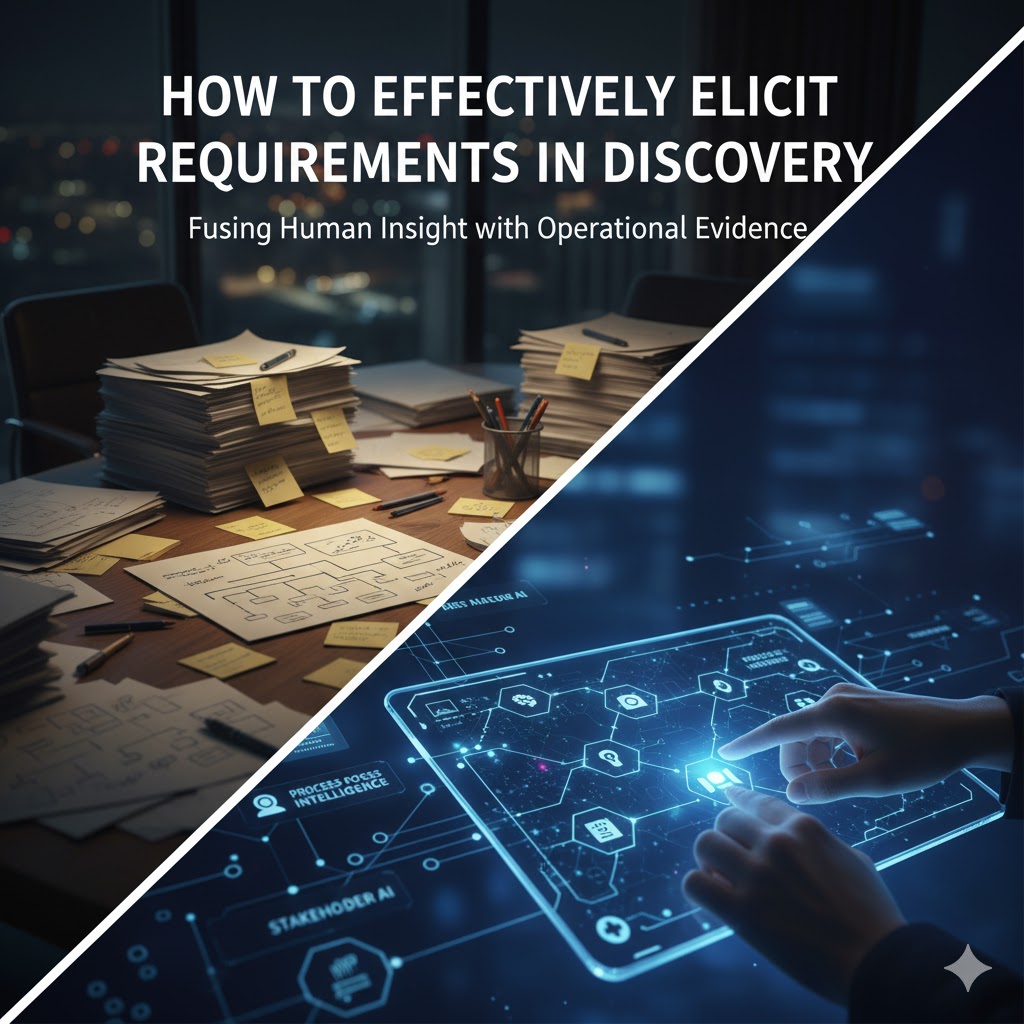
Projects succeed or fail based on how well teams understand what they’re trying to build.
That understanding starts in the discovery phase, where requirements are gathered, clarified, and translated into actionable plans.
But here’s the catch: most discovery sessions still rely on interviews, workshops, and documents that capture what people say they do — not what actually happens.
The result? Gaps, rework, and delayed value delivery.
Modern transformation demands a smarter, data-backed approach to requirements elicitation — one that fuses human insight with real operational evidence.
In the traditional project model, business analysts facilitated workshops and stakeholder interviews to define requirements. Those methods still have value, but they struggle to keep pace with today’s dynamic, technology-driven work environments.
Stakeholders change, processes evolve, and new automation tools emerge faster than requirements can be documented. That’s why leading organizations are now complementing classic elicitation methods with process mapping, task mining, and process intelligence — to ensure discovery captures the truth of work, not just its perception.
Traditional Techniques
These approaches help establish alignment but depend heavily on memory and interpretation.
Modern Techniques
This new generation of tools shifts the focus from anecdotal discovery to data-driven elicitation — creating a foundation of measurable truth.
Process mapping remains essential, but its purpose has evolved.
Instead of drawing boxes and arrows in workshops, today’s analysts use automatic process discovery tools that visualize real system interactions — uncovering handoffs, delays, and redundancies across teams.
With these insights, you can:
A good process map is no longer a static artifact — it’s a living, data-backed model of how work flows.
While process mapping shows what happens, task mining reveals how it happens.
By recording clicks, time on task, and sequence patterns across tools, it exposes the small manual steps that shape performance and user experience.
When combined with process mapping, task mining provides the granularity needed to design accurate requirements for automation and AI initiatives.
It also reduces reliance on assumptions — replacing “I think” with “the data shows.”
Once you’ve captured both process and task-level data, process intelligence platforms aggregate it into metrics that help teams make informed decisions.
Examples include:
This layer ensures that requirements are prioritized by impact, not opinion — a crucial step for transformation leaders juggling limited time and budget.
Despite the rise of automation, people still drive transformation.
Modern elicitation blends stakeholder input with digital data, creating a balanced view of what should change and why it matters.
AI assistants now support this collaboration — surfacing insights, summarizing discovery interviews, or prompting analysts with clarification questions based on anomalies in the process data.
This partnership allows business and IT to stay aligned even as discovery moves faster.
Selecting your technology stack depends on scale, systems, and governance needs — but every effective toolkit should include:
The goal isn’t just to collect more data — it’s to collect better data that links directly to requirements, stories, and design outcomes.
Even with the right techniques, many discovery efforts still stumble. Watch for these pitfalls:
To avoid them, build an iterative discovery loop — one where requirements evolve as your process data updates.
Elicitation is moving from static documentation to adaptive intelligence.
AI will soon be able to suggest requirements automatically based on process data patterns, flag inconsistencies between planned and actual workflows, and simulate the downstream impact of each change.
That’s the direction ClearWork is heading: helping organizations move from reactive documentation to proactive design.
Effective requirements elicitation is about seeing clearly — not just hearing clearly.
By combining structured stakeholder engagement with process mapping, task mining, and process intelligence, you can replace assumption with accuracy and speed with confidence.
To learn how to modernize your discovery phase, revisit our first article, Requirements Gathering 2.0: Laying the Foundation in the Discovery Phase.
Or see how ClearWork’s Automated Discovery platform brings these techniques together — automatically capturing workflows, surfacing knowledge gaps, and transforming them into actionable requirements.
👉 https://www.clearwork.io/clearwork-automated-discovery

Requirements elicitation has evolved beyond interviews and documents; it’s now powered by data, insight, and automation. By combining process mapping, task mining, and process intelligence, teams gain a complete picture of how work really happens. The result is faster discovery, clearer requirements, and transformation projects built on truth—not guesswork.
Enjoy our newsletter!